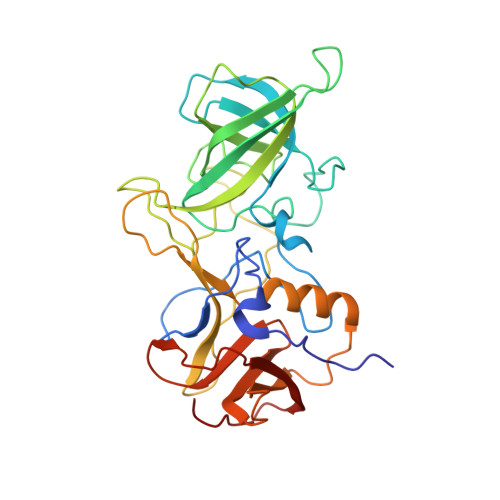Direct Blockade of the Norovirus Histo-Blood Group Antigen Binding Pocket by Nanobodies.
Kher, G., Sabin, C., Lun, J.H., Devant, J.M., Ruoff, K., Koromyslova, A.D., von Itzstein, M., Pancera, M., Hansman, G.S.(2023) J Virol 97: e0183322-e0183322
- PubMed: 36971561
- DOI: https://doi.org/10.1128/jvi.01833-22
- Primary Citation of Related Structures:
8EMY, 8EMZ, 8EN0, 8EN1, 8EN2, 8EN3, 8EN4, 8EN5, 8EN6 - PubMed Abstract:
Noroviruses are the leading cause of outbreaks of acute gastroenteritis. These viruses usually interact with histo-blood group antigens (HBGAs), which are considered essential cofactors for norovirus infection. This study structurally characterizes nanobodies developed against the clinically important GII.4 and GII.17 noroviruses with a focus on the identification of novel nanobodies that efficiently block the HBGA binding site. Using X-ray crystallography, we have characterized nine different nanobodies that bound to the top, side, or bottom of the P domain. The eight nanobodies that bound to the top or side of the P domain were mainly genotype specific, while one nanobody that bound to the bottom cross-reacted against several genotypes and showed HBGA blocking potential. The four nanobodies that bound to the top of the P domain also inhibited HBGA binding, and structural analysis revealed that these nanobodies interacted with several GII.4 and GII.17 P domain residues that commonly engaged HBGAs. Moreover, these nanobody complementarity-determining regions (CDRs) extended completely into the cofactor pockets and would likely impede HBGA engagement. The atomic level information for these nanobodies and their corresponding binding sites provide a valuable template for the discovery of additional "designer" nanobodies. These next-generation nanobodies would be designed to target other important genotypes and variants, while maintaining cofactor interference. Finally, our results clearly demonstrate for the first time that nanobodies directly targeting the HBGA binding site can function as potent norovirus inhibitors. IMPORTANCE Human noroviruses are highly contagious and a major problem in closed institutions, such as schools, hospitals, and cruise ships. Reducing norovirus infections is challenging on multiple levels and includes the frequent emergence of antigenic variants, which complicates designing effective, broadly reactive capsid therapeutics. We successfully developed and characterized four norovirus nanobodies that bound at the HBGA pockets. Compared with previously developed norovirus nanobodies that inhibited HBGA through disrupted particle stability, these four novel nanobodies directly inhibited HBGA engagement and interacted with HBGA binding residues. Importantly, these new nanobodies specifically target two genotypes that have caused the majority of outbreaks worldwide and consequently would have an enormous benefit if they could be further developed as norovirus therapeutics. To date, we have structurally characterized 16 different GII nanobody complexes, a number of which block HBGA binding. These structural data could be used to design multivalent nanobody constructs with improved inhibition properties.
Organizational Affiliation:
Vaccine and Infectious Disease Division, Fred Hutchinson Cancer Center, Seattle, Washington, USA.
















